Answers: April 28, 2022
Here are this week’s answers:
Question 1
BLUEBONNETS FLAT FLOWERS
Dear Neil: Why would bluebonnets have flattened flowers? E.P. near Greenville.
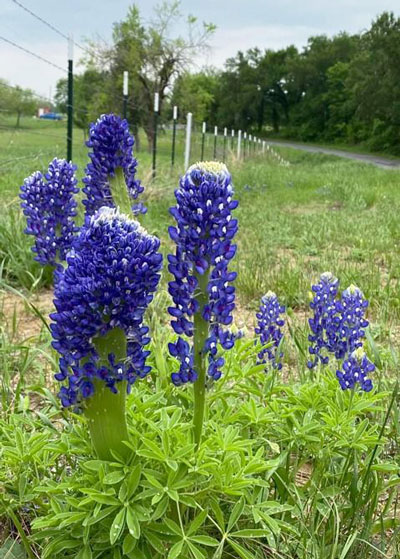
Answer: This is a genetic mutation known as fasciation. It is the same thing you see in the common cultivated flower cockscomb (celosia). Cells divide in one plane only. It also happens with Texas mountain laurels occasionally. In the photo you’ll notice that the stem is also flattened, and I’m sure the leaves are abnormal as well. If those flower spikes set seed, it may be that their seedlings will have the fasciated trait also.
Return to list of this week’s questions.
Question 2
BOXWOODS BAD AROMA
Dear Neil: We have boxwoods that are emitting a very unpleasant odor. No amount of air freshener inside our house can overcome it. I detect it elsewhere in our neighborhood as well. I hate to take them out. What would cause it? D.M. Dallas.
Answer: Flowers, even though they’re inconspicuous. Here’s what Southern Living has to say. (Forgive that they misspell “litter box.”)
Return to list of this week’s questions.
Question 3
RED OAK KILLED PARTIALLY BY COLD
Dear Neil: My Shumard red oak was damaged in the February 2021 freeze. It has come back strongly, but the outer branches appear to be dead. Should they be pruned out? The trunk shows no visible damage. J.M., San Antonio.
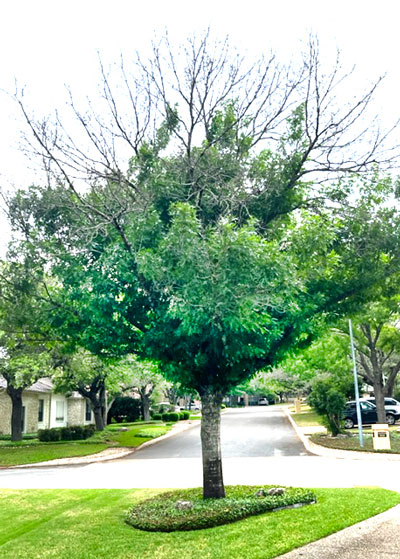
Answer: This is a perfect example of the kind of question I’m hoping to get in this Q&A section. So many people are asking the same thing, so we know others will want to see the answer. Plus, you attached a great and useful photo. Since the trunk appears to be healthy and the new growth is obviously vigorous, your tree should be fine. Yes, have a certified arborist remove all that dead wood. Because red oaks are susceptible to oak wilt, it would be better if you could wait until mid-July when the oak wilt season has passed.
Return to list of this week’s questions.
Question 4
RIDDING PURSLANE FROM GARDEN
Dear Neil: I have a large vegetable garden and each year purslane is a problem. I end up on my hands and knees pulling it because weedkillers say I cannot use those products around my vegetables. Is there anything else I can do? D.F., Lampasas.
Answer: I use a well-shapened hoe on a day when the soil has just begun to dry out a bit. Scrape it across the soil’s surface. Purslane does not come back from its roots. All you have to do is sever it. You can even leave it laying in place. You could also use shredded tree leaves over the soil as a mulch, or you could space your rows so that you could use a roll-type mulch. Purslane should be relatively easy to control – much easier than bermudagrass or nutsedge, for example.
Return to list of this week’s questions.
Question 5
LIRIOPE BORDER DYING
Dear Neil: My liriope border is dying. All I could find on the Internet said “crown rot,” but this doesn’t look like what I saw. Can you please help me? R., Waco.

Answer: I don’t know that I can be precise. Crown rot usually hits the wettest part of a liriope bed. I’ve had the most trouble with it in Silvery Sunproof variegated liriope and also with dwarf mondograss. This looks more like some kind of weedkiller or fertilizer damage. If you wanted to rule out crown rot and other diseases, however, you could send a sample to the Texas A&M Plant Disease Diagnostic Laboratory (https://plantclinic.tamu.edu). Here is the best write-up I’ve found on crown rot. It’s from LSU.
Return to list of this week’s questions.
Question 6
MONDOGRASS NOT COVERING
Dear Neil: I’m having trouble getting mondograss to cover in a bed. What might be wrong? S.C., Brenham.
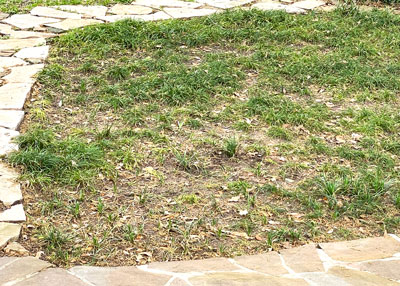
Answer: This question came in moments after the preceding one and I just left it here so you could compare. This does not appear to be crown rot. My guess is that these are plants that would have benefitted from better soil preparation with more organic matter. They may also have needed more nitrogen, and it would help if they were planted more closely. I’ve always found that when I space mondograss too far apart the plants never fill in uniformly.
Return to list of this week’s questions.
Question 7
WHEN TO PRUNE POST OAKS
Dear Neil: I have post oaks I need to have pruned. I know spring is not the time. How soon can it be done? L.G., Somerville.
Answer: Post oaks are not terribly susceptible to the oak wilt fungus. (https://tinyurl.com/48ay6ap8)
Nonetheless, this website might be of interest to you. https://texasoakwilt.org In answer to your question, you can have them pruned whenever you wish. “Sooner” is probably better than “later” to prevent heavy limbs breaking and falling.
Return to list of this week’s questions.
Question 8
RETRAIN CRAPE MYRTLE TO BE TREE
Dear Neil: How to I retrain crape myrtles into trees? They froze a couple of years ago. T., Miles.
Answer: I wrote this page for the website of our Crape Myrtle Trails of McKinney. Please scroll down toward the bottom of the page and you’ll see my reply to your question. (FYI: Your photo did not post with your question.)
Return to list of this week’s questions.
Question 9
CONVERTING MULCHED BEDS
Dear Neil: We have a large property and many mulched beds. As we get older, they are more challenging to maintain. If we were to convert them to something else, what would you suggest instead of all that mulch that has to be spread? M.R., Colleyville.
Answer: I’m in the same boat, and I am changing out a lot of my old color beds to groundcovers. In highly visible spots I’ll use very large pots filled with color, but otherwise the groundcovers will keep things looking tidy and simple. I use regular mondograss in the shade. It holds soil well, plus I can easily blow leaves out of it since it has no runners. In sun I use purple wintercreeper euonymus, Flirt or Harbour Dwarf nandina or Asian jasmine. I really like the wintercreeper because it’s so winter-hardy, plus I like its seasonal color changes.
Return to list of this week’s questions.
Question 10
WISTERIA DOESN’T BLOOM
Dear Neil: Why would a wisteria never bloom? It was in our landscape when we bought our house 15 years ago and we’ve seen no flowers. D.C., Plano. (Same question posted by two others this week.)
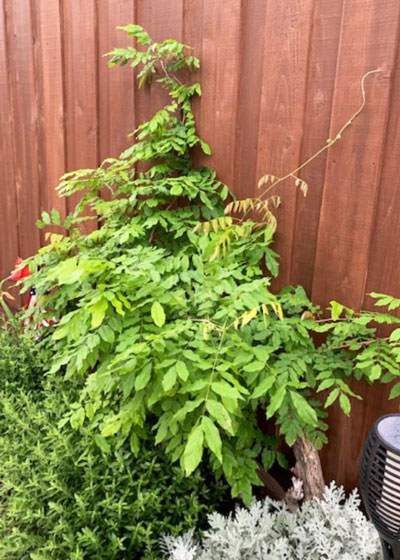
Answer: Here is what I have in the FAQ pages of my website:
This is my most-asked question pertaining to vines. To say the least, it’s a common problem. Often the exact cause will be hard to determine. Factors include shade (wisterias need full sun for best flowering), excessive nitrogen (nitrogen promotes vegetative growth at the expense of flower bud production) and pruning at the wrong time (any major pruning of wisterias should be done immediately after the blooming season).
I might add that root-pruning the plant with a sharpshooter spade in early fall (September) often will trigger the setting of flower buds. Cut the lateral roots by inserting the sharpshooter 12 inches deep in a ring 16 inches out from the trunk (32-inch diameter). Make no attempt to cut tap roots – just the lateral roots.
Return to list of this week’s questions.
Question 11
ST. AUGUSTINE NOT GREENING UP
Dear Neil: Already my St. Augustine is turning yellow. Last year I applied Disease-EX several times. What am I doing wrong? S.A., Stephenville.
Answer: You probably ought to make sure that you’re dealing with Take All Root Rot (TARR), otherwise known as Take All Patch. Send a sample to the Texas A&M Plant Disease Clinic: https://plantclinic.tamu.edu. Here is a good write-up on the disease along with comparisons to other St. Augustine issues. I don’t know when this was written, but Disease-EX is probably the most widely consumer-available source of Azoxystrobin. Other fungicides are also listed. You might opt to try one of those.
Return to list of this week’s questions.
Question 12
RECOMMEND FESCUE?
Dear Neil: Why do you not recommend fescue for shaded areas? We have it, and we have islands of green in the winter and have been pretty happy with it. L.F., Weatherford.
Answer: You must not have heard any of my comments on my Saturday statewide radio program when I answered questions from Northwest Texas. I do recommend it there, because they have cooler nights (to its liking). I also say that in my book Neil Sperry’s Lone Star Gardening. I tried it 8 or 9 years in a row in our pecan-shaded backyard in Collin County (near DFW), planted at the seed producer’s direction, and could never keep it going. Instead of just “over-seeding” it to keep it nice and thick each September, I had to start completely over each time. Brown patch fungus took it out every time in May or early June. The shade wasn’t helping either. I also tired of having to raise my mower two notches every time I went from my front yard (bermuda) to my backyard. For the southeastern 80 percent of Texas St. Augustine is a better alternative, although it, too, must have 5 or 6 hours of direct sunlight to survive. Fescue has been in the Texas market for 45 years. I’m at peace with my position of limited recommendations. Fescue is a pretty turfgrass – where it’s adapted and easily maintained.
Return to list of this week’s questions.
Question 13
WHAT FERTILIZER FOR POTTED PLANTS?
Dear Neil: You suggest an “all-nitrogen” fertilizer for plants in the clay soils (“high-nitrogen” for sandy soils). What should I use for potted plants? J.N.
Answer: They are probably growing in an artificial planting medium. Find a “complete” fertilizer (containing all three major elements: nitrogen, phosphorus and potassium) plus trace elements. Ideally it will have a much higher content of nitrogen. It will be water-soluble, so you’ll need to apply it every second or third time that you water. Apply it as a diluted solution. Periodically flush the plants thoroughly to redissolve all accumulated mineral salts and allow them to exit the pots’ drain holes.
Return to list of this week’s questions.
Question 14
CAN JAPANESE MAPLE BE SAVED?
Dear Neil: The majority of my Japanese maple is dead. Is there any way to save the rest of the tree? Could I root it as a cutting? M.P., Plano.
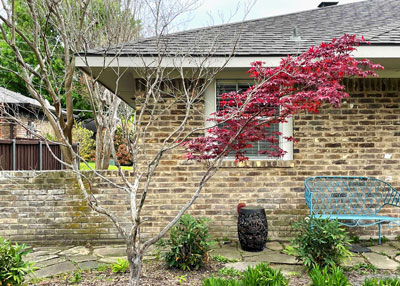
Answer: Technically, you could trim off every bit of the dead wood and reshape the live branch, but the tree would look absolutely bizarre. Sadly, your best bet is to start over with a new tree that is healthy and vigorous. Japanese maples are grafted, not rooted from cuttings. Unless you have an established Acer palmatum rootstock and are highly skilled at grafting already, this just isn’t going to be a plan.
Return to list of this week’s questions.
Question 15
YAUPON HOLLY SUCKERS
Dear Neil: I have a 20-year-old yaupon holly tree that puts out quantities of root sprout suckers each year. I have to dig them out by hand. Is there any other way to eliminate them? R., Lubbock.
Answer: I’ve had good luck, both with yaupons and crape myrtles, in using a sharpshooter spade a day after a heavy rain, to slice into the soil at a 30-degree angle so that I can sever the root that is giving rise to the sprout. Unless you cut that umbilical root 3-4 inches beneath the ground line, it will send up new shoots the following spring. I’ve been able to “convince” my plants that their behavior was unacceptable after several seasons and the need to repeat diminished. Otherwise, there is no spray you can apply because the sprouts are a part of the mother plant.
Return to list of this week’s questions.
Question 16
PLEASE EXPLAIN “ALL-NITROGEN”
Dear Neil: When you say “all-nitrogen” or “high-nitrogen” fertilizer for our lawns and garden plants, are you talking about the entire contents of the bag? I find 46-0-0, so that it only has nitrogen, but it doesn’t seem as “high” nitrogen, since less than half of the bag is nitrogen. I’m confused. B.S., Argyle.
Answer: I can understand the confusion. I’m referring specifically to the three major elements: nitrogen, phosphorus and potassium (N-P-K). In a clay soil, your ideal food would contain only nitrogen (N). So the 46-0-0 would be both “all” and “high” nitrogen. However, there are better blends that have combinations of both slow- and fast-release forms of nitrogen. Shop at a well-stocked, independent retail garden center or hardware store and let them show you the products they offer.
Return to list of this week’s questions.
